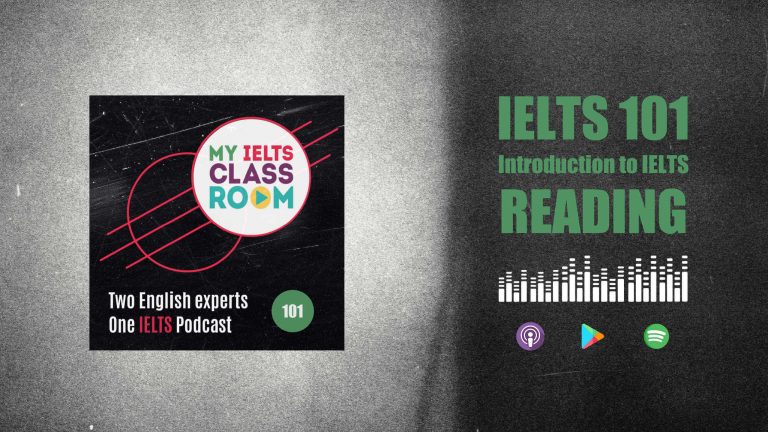
Introduction to IELTS Reading
Hey! Welcome to the fourth lesson in our IELTS 101 series – an Introduction to IELTS reading. Today, Nick and I will talk you through the basic facts of the IELTS reading test, such as how long it lasts, the type of texts you can expect to find in each part, and the type of questions you will have to answer. Then, we will have a more detailed discussion about the different types of reading skills that the IELTS test targets and how you should approach each question (spoiler – scanning does not work for every question!).
Below, you can find a summary of the episode, which includes all of the links to useful materials and the times of each part of the discussion (so you can go directly to the part you want to listen to). You can also find every episode of the podcast here 🚀
Subscribe to My IELTS Classroom podcast on Apple podcasts here
Subscribe to My IELTS Classroom on Google podcasts here
My IELTS Classroom Podcast Episode 4 Summary: Introduction to IELTS Reading
00:00 – 03:09 Introduction to the episode (and why Nick and I rarely read!)
03:10 – 04:59 Basic facts about the IELTS reading test.
The reading test is the second test on your exam day and is different for General training and Academic students. However, there are a lot of similarities between the two tests.
- Both the General Training and Academic reading tests last 60 minutes and have three sections.
- In both tests, each section is more difficult than the one before.
- In both tests, you have to answer 40 questions (e.g. 13 or 14 questions per section).
- In both tests, you will face the same types of question (e.g. Headings Match, True / False / Not Given).
- In both tests, there is NO extra time for you to transfer your answers to the answer sheet. You should do this while you complete the exam.
So, how are the two tests different? Well, the main difference is that in each exam you will be reading different types of texts:
- In the Academic test, you will read three academic passages that are each roughly 800 words long.
- In the General Training Test, you can read up to EIGHT texts in the three sections. In Part 1 – you will have up to 5 passages on topics that test if you can survive living in a foreign country. In Part 2, you will have two passages that are related to work. In Part 3, you will have one long passage on a general topic.
- The number of points that you need for each band are also different. For example, if you are an Academic student, you will need to get between 30 and 32 correct answers to score a 7.0, but if you are a General Training student, you will need to between 34 and 35 correct answers.
05:00 – 09:59 What types of topics can I expect in the passages of the Academic IELTS reading test?
In the Academic test, you will be given three texts that are roughly 800 words each. These will be on neutral topics like psychology, astronomy, animals, social behaviour or the environment. You do not need any specialist knowledge of the topics, but having some background knowledge definitely helps as you will have already met some of the topic-specific vocabulary in the text before.
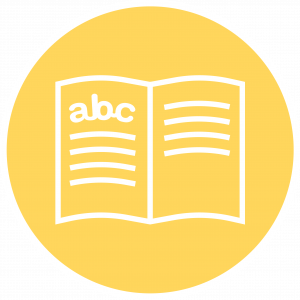
There are two types of text in the Academic exam: descriptive texts (which contain factual information) and argumentative texts (which contain people’s views or arguments). You generally find descriptive texts in sections one and two, which is why those parts of the test are considered easier. It is much easier to read a factual description than it is to read a text that present arguments for and against a theory.
10:00 – 17:35 What types of topics can I expect in the passages of the General Training IELTS reading test?
Even though there are also three sections in the General Training reading test, I think that it canb really be divided into two parts: Sections 1 and 2 (which check that you can FUNCTION in an English speaking country), and Section 3 (which checks that you can cope with a long, general text).
Section 1 is all about checking your ability to survive socially in an English speaking country. This means you will be asked to perform tasks that people do every day such as reading reviews of different products, or reading information about a course you would like to join, or reading an advert for a house share.
These questions tend to check that you can understand or find basic information in multiple texts and focus heavily on vocabulary.
For example, you may be told that a particular watch is “good in wet weather” and the phrase in the text says that “this watch is waterproof” – as long as you know the meaning of the word “waterproof”, you will be able to find the correct answer!
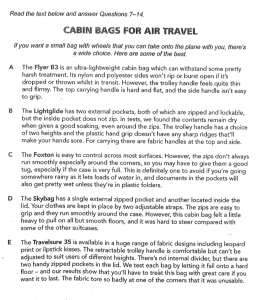
Section 2 is very similar, except now the texts focus on the world of work and, I would say, if you can understand legal texts. For example, you might be given a complicated guide to parking at a university, or a text about health and safety in the workplace.
Many of the questions in this section focus on the language of rules
For example, they check if you can understand modal verbs like “must”, “should” and “can”, or complex verbs like “permitted” or allowed”. Once you have completed a number of General Training tests, you should notice that the same words appear again and again. Therefore, it is really important that you understand these common terms.
Section 3 is different. Not only is it one long text instead of several smaller ones, but the topic is “general”. In fact, the text looks more like one in the Academic test. However, it will feel more like an article from a magazine than one in an academic journal. So, rather than reading about space or architecture, you are more likely to read about leadership, the world’s coldest town, or the development of paper! However, the questions here are similar to those in the Academic test i.e. Headings Match, Information Match, etc.
Also, in the General Training test, the texts are always descriptive, so you will never have to identify a person’s opinion or attitude. That is why when General Training students ask me if they can do the Academic tests for extra practice, I advise against it.
You should NEVER run out of Cambridge practice tests
Remember that they should be used to test your current level, not as a way to improve your performance – but if you do, then only section one in the Academic test is suitable for General Training students (as the texts are similar). However, the questions in Academic section one tend to be slightly easier than General Training section three, so it is better to stick to practicing with just the General Training tests if you can.
17:36 – 17:54 What types of questions will I have to answer in the reading test?
A lot! There are a number of different questions in both tests and each is designed to test a different reading skill. Let’s have a look at ten of the question types here:
17:55 – 21:10 Heading Match Questions
These are the only questions that are given BEFORE the passage. In these questions, you are given a number of possible headings for each paragraph in the passage and some EXTRA headings that you do not need (usually there are around 8 headings, but there can be as many as 11 or 12). There is always ONE heading for each paragraph. Your job is to read each paragraph and decide which heading best matches it.
A heading is a short clause (usually 7 or 8 words) that acts as a summary of the paragraph. Therefore, this type of question is designed to see if you can distinguish main ideas from supporting information and you will not be able to answer this question by scanning. I have a full lesson on how to approach headings match questions, which you can read here.

21:11 – 24:49 Information match questions
In these questions, you are given a piece of information that can be found somewhere in the passage – your job is to locate THE PARAGRAPH that contains the information. For example, if your text was about the IELTS exam (it won’t be!) you might be asked to find “an example of a country whose students do well in the reading test” (so you would read about lots of countries in the paragraphs, but only one paragraph would contain this specific information) or you might be asked to find “a comparison between the exam today and the exam in the past”.
Unlike headings match questions, one paragraph can contain MORE THAN ONE piece of information (i.e. you might decide that paragraph A contains the information for questions 2 AND 7. Therefore, it will be the answer for BOTH questions).
It is also possible that some paragraphs will contain NO INFORMATION (never choose a paragraph just because it hasn’t contained any other answers – very often there is a paragraph that DOESN’T contain any answers!).

This type of question is testing if you can understand the writer’s purpose. Therefore, it is important to remember that you are not looking for individual words but for sentences that perform a function. For example, if you are asked to find “a personal account of somebody taking the IELTS exam”, it won’t help you to scan for “personal account”! These words are used to show that you are looking for a paragraph in which a test-taker describes their own experience of taking the test.
I think that these questions (along with headings) are the most difficult because it is not enough to understand the words in the text – you have to be able to go to the next step and understand the function. Again, I have a lesson that takes you step-by-step through these questions, which you can find here.
24:50 – 25:33 Short Answer Questions
Not all questions are so difficult though! There are also IELTS questions that check your ability to find specific information. Short answer questions are the best example of this. Here, you are given a direct question and have to find the answer in the text. Usually, these are Wh- questions such as who, what, why or when. You tend to find these in the easier descriptive texts in the Academic test and in the first two sections of the General Training test.
25:34 – 32:09 True / False / Not Given Questions:
This is another type of question that can target your understanding of a specific part of a passage, and is perhaps the most famous of all IELTS reading questions. In T/ F/ NG questions, you are given a statement and then you must decide if it
- matches the information given in the text (in which case it is true)
- contradicts the information in the text (in which case it is false) or
- there is not enough information in the text to decide if it is true or false (in which case it is not given).
I want to be clear that “Not Given” does not mean that there is no information about the statement in the text. You will always find a sentence in the passage that connects to the T/F/NG statement. The reason you should choose Not Given is that you just don’t have enough information to know if the statement is True or False. I have a long lesson about the difference between False and Not Given (with lots of examples) that you can find here, but there will be a podcast episode about this very soon.
True / False / Not Given questions are very flexible because they can be used to test a range of reading skills. For example, they might be used to test your knowledge of a single word, or a full sentence, or even if you can follow arguments over two or three sentences.
In fact, there is a whole separate category of this type of question that checks if you can understand people’s opinions. These are called Yes / No / Not Given questions – the basic principles are the same as usual True / False / Not Given questions, but now you are being asked to check the views or claims of the writer rather than factual information (which is usually more difficult).
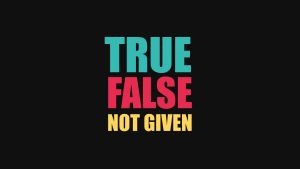
32:10 – 33:27 Matching People Questions
Another question that is commonly used to check your understanding of people’s opinions are those that ask you to match information to a person. For example, you may have a text about competing theories of why the dinosaurs died that contains the ideas of four scientists.
You will be given the names of each scientist in a box and then a summary of each of their theories or beliefs. Your job will be to match each theory to the correct person. Be careful – it is possible that one scientist matches to two beliefs and one scientist matches to none!
There are other types of matching questions. You might be given four animals and have to match them to the correct information or four periods of time. However, no matter what you are asked to match, it is always better to find the items in the box (i.e. the people, animals, or periods of time) in the text and read about them first before matching. This is much quicker than looking for the sentences you are asked to match.
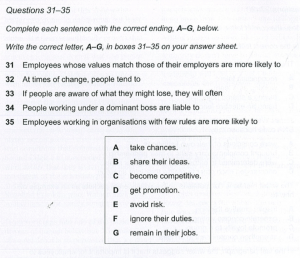
33:28 – 35:41 Matching ends of Sentence Questions
Another type of matching question is when you are given the beginning of a sentence and asked to find the correct end of the sentence from a range of options in a box.
This is an interesting type of question as it not only tests your ability to find specific information in the text (remember that the answers are in the passage!) but also your knowledge of grammar. This is because your final sentence must be grammatically correct. It is very common to have one or two options in the box that match the correct meaning of the sentence in the text, but do not fit grammatically.
However, that is not always the case. If you look at the example to the left, all of the question stems end with a word or expression that must be followed by an infinitive and so all of the endings in the box start with one!
35:41 – 37:50 Completing sentences, notes, flow charts and summaries
The other type of question that tests your grammar are those that ask you to find a word in the text that complete sentences, notes, or a summary of the passage. Here, it is again important that the word you choose creates a sentence that is grammatically correct. Remember, you must never change the word from the text to make it fit the space!
In general, it is easier to complete a sentence in the form of notes than it is to complete a summary of a paragraph or a whole passage but you should approach the questions in the same way.
- Step one is always understanding what type of word you are looking for. Is it a verb, or a noun, or even an adjective?
- Then try to find the sentence in the passage that the question is targeting. To do this, you should try to match the key word in question to words or synonyms in the text.
- Finally, find the word in the passage that completes the sentence so that it is meaningful and grammatically correct (this is often harder than it sounds!).
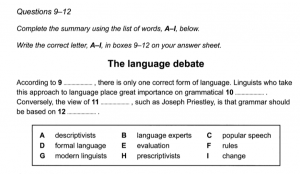
You should also know that there are two types of summary completion – those where you have to complete a sentence with a word from the passage and those where you have to complete the sentence with a word from a box. Although having the words in the box may seem easier (because at least you know the answer is in the box!), I find that these questions are often more difficult. Firstly, the words in the box rarely match the words in the text. That means you will need to find the words in the passage and then a synonym for that word in the box – I have found in my classes that students can often find the word in the text, but they don’t know the synonym for that word in the box! This is where having wide lexis becomes important!
37:51 – 38:44 Multiple Choice Questions
Multiple choice questions appear in both the listening and reading tests. However, in the reading test, you will be offered four possible answers rather than three. The key thing to remember is that every one of those options will have words or ideas that are mentioned in the text, so you cannot answer these items by scanning. You will need to read carefully to locate the only piece of information that is true.
To do this, you may find it helpful to eliminate the wrong answers as you read as sometimes it is easier to know what is wrong than what is right! These items can be used to test a range of reading skills from locating main ideas to testing a specific lexical item. In fact, they can even be used to test if you understand the writer’s purpose for writing the whole text – that means you could have to be able to identify the correct title for the text!
Want help with Multiple Choice Questions? Listen to this more recent episode of the podcast
38:45 – 39:45 Labelling diagrams and maps
Our final type of question is labelling a map or a diagram. These are the rarest type of question but when they appear they require you to follow a description of an object (such as a water pump or a geographical feature) and label the different parts of the objects based on the information in the passage.
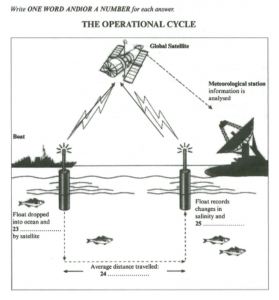
40:20 – 50:30 How should I start preparing for the IELTS reading test?
Again, the best way to understand what happens in the test is to do one. Therefore, I recommend that you find a Cambridge book, make a cup of tea and just do two or three tests. Unlike listening, one test is not enough for you to experience all of the question types because not every exam has a headings match question, or asks you to complete a summary, so you really do need to do two or three to make sure you have seen and tried all of the question types.
Please note in Books 6 – 12, there are four Academic tests, but only two General Training tests (at the back). From Book 12, Cambridge began to publish separate volumes for each test.
Therefore, if you are a General Training student make sure you buy 12, 13 or 14 because you are going to get far more tests for your money!
Once you have completed the tests, have a look at your scores to see how close you are to your target score.
| IELTS Band | Reading (Academic) | Reading (General) |
|---|---|---|
| 9.0 | 39 - 40 | 40 |
| 8.5 | 37 - 38 | 39 |
| 8.0 | 35 - 36 | 37 - 38 |
| 7.5 | 33 - 34 | 36 |
| 7.0 | 30 - 32 | 34 - 35 |
| 6.5 | 27 - 29 | 32 - 33 |
| 6.0 | 23 - 26 | 30 - 31 |
| 5.5 | 19 - 22 | 27 - 29 |
| 5.0 | 15 - 18 | 23 - 26 |
| 4.5 | 13 - 14 | 19 - 22 |
| 4.0 | 10 - 12 | 15 - 18 |
If you are within 3 or 4 points of your target score – great! What you need to do now is learn the different techniques for each question. For example, the way you look for answers to Short Answer Questions is not the same as the way you look for the answers to Headings match questions (in fact, they require almost opposite skills). As I said before, I have some great free lessons on my blog for reading, so you can go there to find help in improving your technique for specific questions.
However, if you are six points or more from your target score, the problem is probably not technique but your language. In this case, I would advise you to stop preparing for IELTS and go to a school to take some general English lessons before continuing. This will make your total IELTS journey much shorter and less painful (trust me!).
50:31 – 53:30 How difficult is the IELTS reading test compared to the other parts of the exam?
It is very common for students to get higher scores for speaking and listening than reading and writing. This is because there are far more academic skills involved in academic reading and writing than the other two skills. If you are able to get a high score in listening, but struggle with reading, then it is probably your technique which is at fault. I recommend that you find a teacher to help you – often strong students can improve quickly once they understand the skills involved in reading.
53:31 – END Do you have any final tips for IELTS reading?
- Use the titles of the texts to understand the general idea of each passage before you start tackling the questions – this will help your brain to start processing the information as quickly as possible.
- Always read the questions before you start reading each passage – you must actively read in the IELTS test. This means that you should know what you are looking for before you start to read. Underline key words to help guide you as you read.
- You should answer the questions as you read – don’t read the whole text and then look for questions. There are 13 or 14 questions in each section and it would be impossible to remember them all! You are welcome to read the whole text, but make sure you answer the questions at the same time!
- Like the listening, check the number of words that you are asked to give for each answer – don’t write more or you will automatically lose the point.
- Only use words from the texts – you must NEVER change the word from the passage in your answer. If you need to change your word, it is not the right answer!
- Each section is more difficult than the one before, so divide your time correctly. If you are an Academic student, I think that 15, 20, 25 is a good target (i.e. spend only 15 minutes on Section One and 25 minutes on Section Three). If you are a General Training student, try to get to Section 3 with 25 minutes left, but do not rush Sections 1 and 2 – remember that you need all of the points and mistakes are costly!
I hope that this introduction to IELTS reading has given you a great idea of what skills you will need to develop before you sit your test. You can find lots more free reading advice on this blog (just have a look for “Reading” in the menu above).
We also run a 5-day intensive course for both the General Training and Academic Reading modules every month. In these, you can learn how to tackle every type of reading question well and learn powerful techniques to help with time management. 🚀
